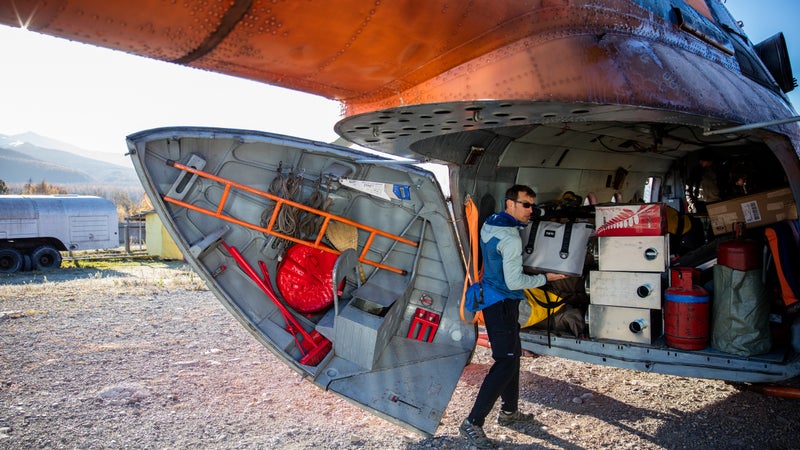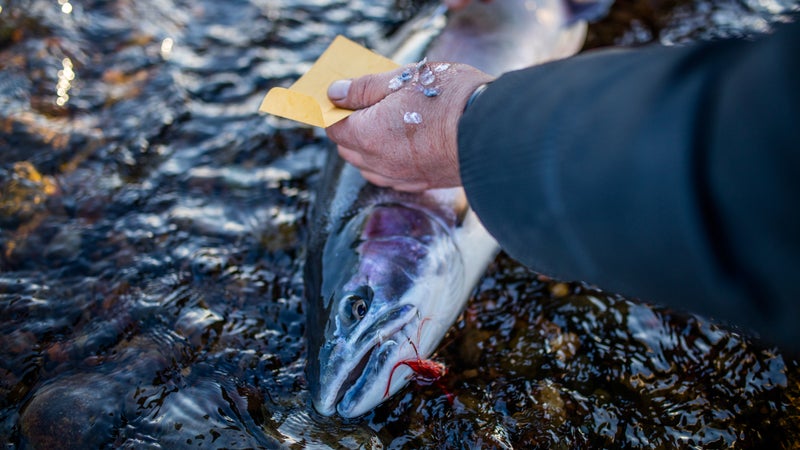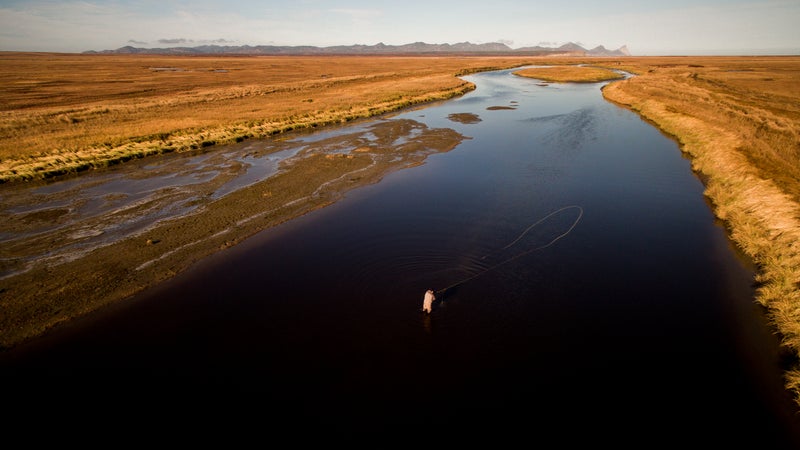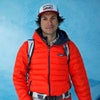Go (18 Time Zones Over Seven Days, All to Catch an Insanely Beautiful, Kremlin-Protected, Gargantuan) Fish
Halfway around the world, fly-fishing scientists are unraveling the secret lives of giant steelhead—one cast at a time
New perk: Easily find new routes and hidden gems, upcoming running events, and more near you. Your weekly Local Running Newsletter has everything you need to lace up! .
The steelhead was delicious. Our guide Ryan Peterson, a 39-year-old self-taught Alaskan ichthyologist who’s been traveling to Russia’s far eastern peninsula of Kamchatka��for the better part of a decade, emerged from the camp kitchen with a tin salad bowl stacked high with thick slabs of pink trout meat sprinkled with dill. “It wouldn’t be Russian if it didn’t have dill,” he said. The fish, a silver-colored female 32 inches long and 19 inches around the middle, had probably swum into the Kvachina River estuary that morning from the Sea of Okhotsk—it still had sea lice on it, which fall off after a few days in fresh water. Ryan had marinated it in teriyaki before cooking it over a fire behind the 10-by-30-foot plywood cabin that served as the camp’s mess hall.��
“A toast to the forbidden fruit,” he said, raising a glass to the protected fish that we’d traveled 18 time zones to see and study. Our group included nine anglers, three Western guides, 33-year-old Russian outfitter Anatoly Tureshev, a representative from Moscow State University, and “Big Sasha” Andryukhin, a Russian guide and former police captain who wouldn’t discuss the provenance of his tattoos.��
The camp sat on the bank of the Kvachina River, two miles from the equally fishy Snotalvayam River, an hour by Russian Mi-8 cargo helicopter from the town of Esso. For a few weeks in the fall, this is field headquarters of the , a research partnership between the Seattle-based , a spin-off from the ; Moscow State University; and the Russian Academy of Sciences. Since 1994, when it was cofounded by Seattle fisherman and conservationist Pete Soverel, the KSP has used well-heeled Western fishermen to catch, tag, scale-sample, and release these oversize, anadromous rainbow trout. By offering the��almost unheard-of chance to swing a fly over the heads of unmolested wild steelhead, the project avoids paying for data collection and gets a financial boost from the sponsoring anglers, as they’re called, each of whom make a tax-deductible $12,500 donation.
“Steelhead are listed in the Russian Red Data Book of rare and endangered species,” Ryan said. That’s not because the fish is doing poorly but because it inhabits only a small number of Russian rivers. Historically, steelhead had a wider range in North America, populating rivers and streams from San Diego to Alaska. Today they are either in decline or have been extirpated from most of��those rivers. For example, scientists believe there were once between 11 million and 16 million salmon and steelhead in the Columbia River Basin alone. By the early nineties, wild steelhead populations upstream of Washington’s Lower Granite Dam on the Snake River, a tributary of the Columbia, had dipped below 10,000. (Runs have since recovered, numbering 39,000 in 2015.)��
Overall population estimates for Kamchatkan steelhead are tough, because research is under way on just three rivers. We know that roughly 8,000 to 9,000 fish return annually to the Kvachina; extrapolating from that, there are probably no more than 100,000 steelhead in Kamchatka, the entire native population outside North America.��
“They’re just rare,” said Justin Miller, the trip’s lead guide. “There are only a couple of watersheds that have them. Instead of waiting for them to be on the brink, Russia protected them.” You can’t legally fish for steelhead in Kamchatka any more than you can hunt for tigers in Siberia. So these remote populations represent an ideal study pool. “The main collectors of the biological data are anglers,” said Kirill Kuzishchin, a Moscow State professor who advises the project. “I don’t distinguish fishing from research. A good angler is a good scientist.”
Fly-fishing, it turns out, is responsible for some of the lowest mortality rates when used to sample fish populations, compared with methods like seine netting and electrofishing—essentially hooking up a car battery to a river pool and seeing which stunned specimens float to the surface. Of course, there’s still the occasional casualty. The fish that ended up on our plates had been what Justin called “a bleeder,” one that took a barbless #1 Dai-Riki hook in the gill—like a Bic pen to the jugular—causing a mortal wound that necessitated a quick pithing by multitool. If the first rule of catch-and-release is to get the fish back in the water unharmed, the second is to honor the one in a hundred or so that don’t make it. Thus, this fish became a most memorable dinner—thankfully, on a night when the camp’s two indigenous Koryak camp hands, Evan and Pavel, had planned to serve liver.
Autumn in Kamchatka��is a narrow calendar slice between mosquito season and the cold grip of subarctic winter. On our first morning in camp, a thick coating of early-October frost covered the network of mud and boardwalks connecting the tents. The tiny Kvachina River would soon be locked beneath layers of ice and snow, the steelhead in a hibernative stupor, waiting for the spring thaw that would signal the time to spawn and return to the ocean. But for five weeks each fall, the area is a perfection of warm days and cold nights, an endless expanse of heath and dwarf shrubs turning gold, and bears��gorging on spawned-out chum salmon.��
We donned waders, and Ryan fired up the outboard jet motor on the flat steel-hulled Zodiac. We were headed to a spot he called “the 100 percent hole,” an outrageously optimistic name given steelhead’s reputation as the fish of a thousand casts. But in the States, that has more to do with how badly we’ve treated the places where the fish live. Eleven of the 15 distinct steelhead populations along the Pacific coast are protected under the Endangered Species Act, threatened by dams, pollution, and fishing pressure. For American anglers, those fish have become something of a spiritual bridge back to a time of pre-dam abundance. To cradle one in the water is to catch a fleeting glimpse��of the wildness we traded for cheap hydropower and flood prevention.

Traveling with Travis Rummel—his made fishermen all over the world lust for Kamchatka—I had spent three days flying halfway around the globe in a suspended state, not unlike an overwintering steelhead, before landing in the Cold War citadel of Petropavlovsk-Kamchatsky, where President Vladimir Putin parks his nuclear submarines. From P-K, we traveled seven hours north to Esso on Kamchatka’s only highway, in a Daewoo bus that required a push start. From there it was an hour by helicopter to camp.
So it was understandable that we were still a bit dazed as Ryan piloted the boat downstream. North American steelhead rivers tend to be large, but, said Ryan, “We’re catching steelhead in a river that’s 40 feet wide and eight inches deep.” Ahead of us, the channel came to life with bow wakes of giant steelhead scooting out of the way. He turned off the engine and guided the boat into a gravel bar upstream of an innocuous-looking cutbank with a tiny flutter of nervous water running past it. Steelhead will pile into slack pools while they’re running upstream to spawn, but catching them on a fly requires a special combination of circumstances: current to move the fly past the fish, and some sort of natural structure, like an underwater boulder or riverbed depression, that gives the fish a place to rest.
On the six-mile stretch of the Kvachina that the KSP studied last fall, there were only about a dozen such spots, each with a corresponding name given by Steelhead Project guides over the past 20 years: the Penthouse, the Lobby, Sloppy Seconds, the Arm, the Anchor.��
The Kamchatka Steelhead Project
Yeti Presents: Kamchatka Steelhead Project is a film from Felt Soul Media and Yeti Coolers about what happens when you enlist fly-fishermen to help��study and preserve one of the world's last great steelhead populations.
“Nobody’s quite sure why a steelhead takes the fly,” Ryan said. “Maybe they’re curious, and fish don’t have hands.” Steelhead don’t eat when they’re preparing to overwinter, so hunger is out of the question. Experienced anglers talk about the fish having personalities and moods. Happy wild steelhead will investigate almost anything that drifts past them: a leaf, a bug, even a bird flying low over the water. For whatever reason, though, the fly, a colorful poof of feathers that Ryan says is more for the angler than the fish, needs to be swinging like a pendulum at the end of the line, away from the bank.��
“Around Oregon and Seattle, the aggressive fish that will take a fly on the swing have all been killed,” Ryan told me. The remaining fish tend to be caught on a pattern that replicates a trout or salmon egg and dangles shamefully beneath a bobber. Fish will reliably take an egg pattern as a way of killing off future competition, but as a matter of style for the angler, it’s the difference between using water wings and swimming.��
Ryan unspooled some line from his spey rod, a 12-foot eight-weight. I’d always had the impression that these big rods require more muscle, but it’s just the opposite. With a series of highly choreographed movements, he ripped the line off the water and into a giant D-shaped loop before sending it shooting across the river with barely a flick of his bottom hand. The simple,��repetitive motion of spey casting is so calming and meditative that steelheaders often brag about how many weeks they’ve gone without catching a fish. Persistence is a mark of pride. Cast to the far bank. Take two steps downstream. Repeat. In the Pacific Northwest, catching even one fish a season is considered success. Like getting your elk for the year. Here it wasn’t that hard.��
On the third or fourth cast, Ryan called his��shot. “Get ready,” he said. The line went taut. A second later, the little patch of nervous water by the cutbank erupted.��
A steelhead, it turns out, is an ordinary rainbow trout that just happens to have more miles on it than my Tundra. Trout aren’t born steelhead; it’s a lifestyle choice.
There's a common��misconception about steelhead, which are born in the river, migrate to the ocean like salmon, and then return to the same river several times over the course of their lives to spawn. It holds sway even among serious anglers and can lead to fights and lost face—bets made and the results and consequences then disputed. The debate centers on the relation between a steelhead and a rainbow trout. Is it a close relative? A near neighbor? A strain? A breed? A varietal that’s imprinted with the innate desire to head for salt water as a young smolt?��
Only in the past 15 years have scientists settled the question definitively, using DNA testing. A steelhead, it turns out, is an ordinary rainbow trout that just happens to have more miles on it than my Tundra. Trout aren’t born steelhead; it’s a lifestyle choice. If there’s plenty of food where they hatch, they’ll stay put and become regular rainbow trout. If food is scarce and the ocean is accessible, one theory goes, they’ll adapt to salt water and risk the dangers of sharks and tuna. The fish that survive come back looking like the Hulk, but they’ll still interbreed��with the scrawny hometown rainbows that stayed put and got a job at the local Circle K.

One of the most important developmental factors, the Kamchatka Steelhead Project has learned on the Kvachina, is a diversity of life strategies, even within the same run. “It’s not just one big population,” according to Guido Rahr, the president of the Wild Salmon Center in Portland, Oregon. “It’s dozens of little populations.”
“There are fish that go to the estuary and stay in the estuary and do not go to the high seas,” Kirill told me. “We found that some fish go from the river to the estuary for a short period and come back to the river after several weeks or several months of foraging in the estuary.” Kamchatka is a model of strength by diversity.��
It’s also where the rainbow trout was first identified by science, in 1792. Its Latin name, Oncorhynchus mykiss, is derived from the local Kamchatkan word for the fish, mykizha. It was originally classified among the Salmo genus, which contains Atlantic salmon and European trout species like brown trout. But it was finally reclassified as Oncorhynchus, which includes the five commercially fished species of Pacific salmon.
Among our crew was , a research scientist with the Washington Department of Fish and Wildlife, who’d been sent to Kamchatka in hopes of creating a similar collaboration between anglers and scientists on the Olympic Peninsula, studying rivers like the Hoh and the Sol Duc. The idea would be to train anglers to record and tag the fish they catch, building a larger data set than state employees can collect on their own.
“The usual notion is that when a population is depressed, you need to flood the system with hatchery fish,” said Soverel. Currently, the Idaho Department of Fish and Game, as well as federal hatcheries, release more than 9.6 million steelhead smolt into the Snake River system each year. But the ideology behind that plan is starting to change with the recognition that big, healthy trout are a product of big, healthy ecosystems. One of the best strategies for improving steelhead runs is to remove dams. Just a year after the Elwha and Glines Canyon Dams were blasted out of Washington’s Elwha River in 2012, wild steelhead reappeared upriver.��
Around the dinner table at the Kvachina camp, several of us were still struggling to wrap our minds around the idea that the size and power of the steelhead has little to do with genetics and mostly to do with environment.��
“A steelhead is a rainbow trout,” Ryan said. “It’s a fish everyone in North America knows. If you’re a fisherman, you’ve caught one in any number of rivers all up and down the West Coast and the Rocky Mountains.”
Rainbow trout can move anglers to poetry and philosophy. But steelhead break up marriages and end the otherwise productive employment of the men and women who dedicate their lives to chasing them.��
��
Ryan handed me��his rod and walked me through the spey cast. First, setting the anchor—the fly—in the water just off my upstream shoulder. Then, in a slow, consistent upward arc, creating the D-loop with the top of the rod. Finally, with a quick lever of the bottom hand, shooting the rod tip forward. Do it wrong and the line collapses into a tangle, no matter how much force you put into the rod. Do it right and the line shoots effortlessly to the far bank.��
After 20 casts or so, I felt a bump. Steelhead tend to grab and gum the fly. If you try to set the hook by raising the rod tip, you’ll miss it every time. Instead, I suppressed every instinct I’ve learned over two decades of trout fishing and waited. Eventually, the fish turned downstream, and the hook set naturally in the corner of its jaw. Line began to sing off the reel, and suddenly I was fighting a 28-inch fish in eight inches of water. It’s the sort of thing that inspires Oregon bumper stickers like The Tug Is the Drug.��
“Somebody could describe the human feeling after a thunderbolt hitting him,” Kirill said, idiosyncratically, when I asked him what it’s like to catch such a big fish. “Really, one have to feel it, and there will be not needed any words.”��
The data-collection process involves��measuring length and girth, collecting ten scales from each side of the fish, and inserting a small numbered hang tag in the dorsal fin. In 20 years, KSP has recaught fewer than 50 fish from a previous season. These recaptures, as they’re called, are incredibly valuable to the project. We got two last fall.��
I’m generally skeptical of adventure vacations that use science as a banner justification, as if mountain summits can be accurately measured only by climbers, shark behavior understood only by sport divers attaching GoPro cameras to their fins, or global warming confirmed only by skiers traversing the Arctic or snorkelers exploring the Great Barrier Reef. Science is this decade’s “raising awareness,” the idea being to attach a charitable cause to a trip in order to make it seem somehow laudable.
This one, though, has the advantage of paying for the research through the sponsoring anglers. The Steelhead Project has also succeeded in curtailing the small but deadly illegal fishing operations that set up on the Kvachina and Snotalvayam Rivers after the fall of Communism. When the economy collapsed, a black market for salmon caviar made Kamchatkan fish a lucrative target for organized crime. A 2008 study by the World Wildlife Fund found that “despite a fishing ban, the stock has declined in recent years. No fishing is officially recorded; however, the valuable trout are extensively poached.”��

Before he launched the KSP, said Soverel, commercial poachers would show up in tanks, having driven across the open tundra from a town like Tigil, 100 miles to the north. These operations could easily kill upwards of 2,500 fish—a third of the Snotalvayam’s entire run. In the project’s early days, a Russian fish inspector named Sergey Lamzov accompanied the KSP and intervened.��
According to Soverel, on one of those early trips a local military commander, a major, was leading an illegal fishing operation, driving a civilian version of the big Soviet-era tanks upriver, carrying a gill net. Sergey stopped him. The major told him to go “fry ice.” Sergey noticed that the major had a Kalashnikov and asked whether it was a government gun or his personal weapon. If it was a government gun, then the major had taken it from the armory on personal business. If it was a personal gun, then it needed to be registered. As soon as the major realized he was at risk of a much more serious violation, he turned his operation around. The story spread quickly through Tigil.
“We have eyes and ears on the river,” said Rahr. “I think the KSP has reduced steelhead poaching just with our presence.” Now, said Soverel, the situation has gone back to what he calls “babushka poaching,” just a few locals stocking up on fish for the winter.��
“Somebody could describe the human feeling after a thunderbolt hitting him,”��Kirill��said��when I asked him what it’s like to catch such a big fish.
Kamchatka��is wild, but it’s no wilderness. Travel on the tundra is done mostly by those treaded tank vehicles. Even to reach the Snotalvayam River, Big Sasha had to drive a Polaris ATV that looked like a souped-up golf cart with a pickup-truck bed. Because virgin tundra supports a wheeled vehicle better than the rutted soup it becomes with repeated travel, the off-road track to the Snotalvayam was 100 yards wide in places.��
It’s a problem that Rahr recognizes. Kamchatka is like��a time machine that deposits humans two centuries into the past—into an era of abundance. But that abundance can’t withstand our modern footprint. “The Russians have a chance to create protected areas,” Rahr said. “It’s a wilderness now, but the world is going to change over the next 20 years.” As in other parts of the world, people here are skeptical of being told what to do by Americans. “Russia needs to take the lead,” said Rahr.��
For now, the Kamchatkan wilderness remains a highly motorized affair. During one high tide, we jetted downstream to the estuary and filled two giant duffel bags with Japanese fishing floats that had washed ashore. The green glass orbs occasionally turn up on the American coastline, too, but collectors are quick to scoop them up. Their presence here is a sign of just how few people ever come to this spot.��
By our fifth day on the river, Anatoly, the outfitter, wasn’t liking the weather. We were supposed to camp for another four days, but the first winter storm of the year was moving across Siberia and would soon pick up moisture over the Sea of Okhotsk. We could either call in the helicopter the following day or risk being stranded for a week. The narrow shoulder season was coming to an end.��
On October 17, our last day in camp, the sound of a tank echoed off a cutbank in the river. The locals were out fishing the Snotalvayam. Big Sasha went down to meet them, and soon the sound vanished in the distance.��
Had he broken up a poaching ring? Had he laid down the law? Sasha made it seem like��a mellow encounter. “They were just like you-and-me kind of people,” he said in his thick accent. He’d sent them upstream and out of sight.
is an �����ԹϺ��� Editor at Large.


